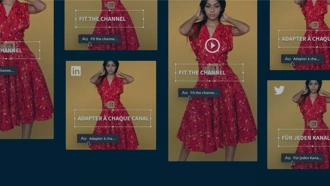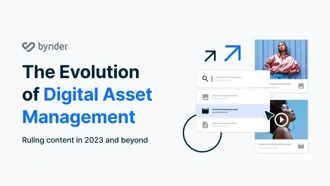What is social media asset management?
The rise of social media has forever altered the way users consume content online. With an ever-increasing amount of content being fed to users everywhere and the ability to reach an unprecedented number of people, it's no wonder that social media marketing has been growing steadily over the last few years. But with so much content being pushed online at any given time marketers need to cut through the noise and reach consumers with relevant, high-quality, brand-consistent content that resonates with their audiences.
Each social media platform plays by its own rules. Each demanding a specific format, creatives are often burdened with creating video and static content that fits every channel and screen size, while marketers struggle to populate channels correctly and keep track of what assets and campaigns belong to specific platforms.
Social media asset management is a class of software that allows creatives and marketers to create and share content faster while safeguarding brand consistency and reaching audiences effectively. The best social media asset management systems combine creative automation templating tools—that allow creatives to boost social asset production—with a central repository from which marketers can easily collaborate on, share, and distribute assets effectively.
Bynder's social media asset management system and creative automation tools help creatives and marketers meet the growing demand for video, dynamic, and static social content. Entirely cloud-based, they ensure seamless collaboration across remote teams, secure and streamlined communication with external stakeholders, and automated distribution to populate the right channels, at the right time. See how Bynder can help your organization achieve its social media marketing goals with a free demo.
Discover Studio
Scale up video content creation for social media with Studio. Create and localize endless on-brand variations of your video assets to fuel segmentation and personalization.
What are the challenges of social media marketing?
The goals of social media marketing are varied: from building brand awareness to finding new customers and engaging them regularly while distributing relevant content. But social media marketing is extremely fast-paced. With less than two seconds to grab a viewer’s attention and a never-ending supply of visual content, posts become outdated in a matter of minutes.
The challenges that social media marketers face more often are:
- Very short production cycles
- The need for endless content variations
- Maintaining consistency across channels
- Communicating effectively with external agencies and stakeholders
- Meeting the demands of creative optimization
- Populating channels manually
Creative automation tools like Bynder's Studio, paired with a state-of-the-art digital asset management system for social media effectively help marketers shorten production times, reach audiences effectively across channels, and increase ROI.
With Bynder, within 30 seconds, I can tag, sort, and label new assets so that my team can use them instantly. The same goes for videos. We post all of our finished video content on Bynder and we use it cross-team with the social media team.Michael Robinson
Creative Director at Nautilus
What are the benefits of using Bynder's social media asset management solution?
Anytime, anywhere asset sharing & access
Digital asset management for social media makes asset sharing and accessibility simple. Assets are shared securely without needing to resort to dangerous email attachments, FTPs, physical hard drives, and shared servers. Easily configure different levels of permissions and ensure the right people have access to the right files.
Create, collaborate and share company content from one place
DAM for social media provides a central hub for your team to manage content from ideation to publication. You can review, assign, and approve digital assets easily and quickly. That way, you’re always delivering content that is consistent and on-brand. There's no need to leave the portal either; simply share your files within your team and to external parties directly from the DAM.
Easy publishing & distribution
With a DAM in place, you can keep all your social media assets in one location while easily pushing them to the right channels and third-party distribution services.
A faster way to produce on-brand social assets
With Bynder's creative automation tools, creatives can instantly turn design files for social media, banner ads, and other on-brand digital content into editable brand templates that anyone can reuse—no design or video skills needed.
Boost localization and personalization efforts
Bynder’s creative templating tools speed up content creation at scale. Whether you need localized content or targeted ads to fuel personalization, Bynder lets you create and distribute endless variations of your designs in minutes.
Ensure brand consistency
With Bynder’s DAM, when creations are approved, only the latest version becomes available to download or for use in all other integrated modules. By defining elements and rules that control the way designs are edited, creatives and marketers can rest assured that all creations are always on-brand and ready to be shared.
Boost social content performance and increase ROI
With Bynder’s content creation modules and features, you can create video and banner ads at scale to fuel optimization algorithms. By gaining insights into asset performance and pushing only the best performing content, you can effectively cut costs and significantly increase ROI.
Populate channels in seconds
Bynder integrates seamlessly within your wider tech stack. With no need to download and re-upload assets before distributing them, populating channels quickly, automatically, and error-free has never been easier.
Frequently asked questions about social media asset management
Who needs a social media asset management system?
A social media asset management system is helpful to any company—big or small—that uses internet and social media marketing for its promotion. Whether asset creation is done in-house or contracted to creative agencies, both the marketing and sales teams can successfully leverage social media asset management to manage, store, collaborate on, and distribute the right assets across channels—and increase ROI.
What’s the key to successful social media marketing?
The goals of social media marketing are to connect with an audience and build brand awareness, find new customers, and engage with them regularly while distributing relevant content. To increase sales, drive traffic to their website, and generate new leads, brands must respond instantly to their users’ constantly evolving wants, needs, and expectations by using strong visual language and creating content that is platform-fit and tailored to their specific audience. With a social media asset management system and the right creative automation tools, marketers can boost social content creation at scale and increase revenues while decreasing efforts.
Why is it important to pair social media asset management with creative automation tools?
A social media asset management system is the best way to store all your social assets in one place and distribute them effectively and error-free. It offers collaboration features that streamline communication across remote teams and with external stakeholders while keeping assets securely stored and accessible only by the right people. Creative automation tools are designed to help creative teams boost their social content output at scale by automating some aspects of the production process. Implementing creative automation tools with a social media asset management system is the best way to ensure a robust and consistent brand presence across channels and platforms.
Can I get a demo of social media asset management?
A demo is a great way to learn about the product and understand how it could benefit you, with a helping hand from one of our consultants. See Bynder's social media asset management in action as well as our creative automation tools. There is no obligation to buy, and the demo can be arranged at a time that best suits you.


